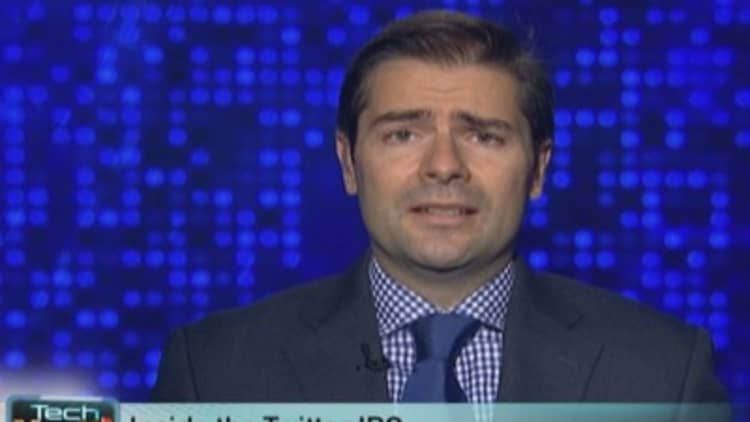
Twitter's latest S-1 filing didn't just reveal that it has chosen the NYSE over the Nasdaq—but also how the company fared in the third quarter. After Twitter's first half results sparked concerns that the company wasn't growing its users fast enough but was growing its costs too quickly, these newest numbers address some concerns—and fuel others.
The Good: Third quarter revenue growth continues to accelerate, more than doubling to $168.6 million from $82.3 million in the year-earlier quarter. And Twitter is showing Wall Street it has even more strength in the all-important mobile space, with 70 percent of ad revenue now coming from mobile, up from 65 percent at the end of June.
(Read more: How Nielsen gauges Twitter TV audiences)
This contrasts with Facebook, which generates just over 40 percent of its ad revenue from mobile. And since most ad-based businesses like Twitter generate their highest revenue in the fourth quarter, the company is well on its way to exceeding eMarketer's projections of $580 million in revenue this year. And the company said it is generating more revenue from each time its users look at Twitter's timeline, increasing the number of ads users interact with.
The mixed: The company reported 232 million users, 6 percent more than the 218 million it reported at the end of the second quarter. While it looks good that in just three months the company added as many users as it did between December, when it reported 200 million users, and the end of June, the year-over-year growth rate is slowing.
Cause for concern? Twitter's net loss more than tripled to $64.6 million in Q3, up from $21.6 million a year earlier. That makes Q3 Twitter's worst quarterly loss on record. Why? Twitter is investing in expansion, and expenses are soaring, up 30 percent from the prior quarter and more than double from a year earlier. The company added 300 employees in the quarter and is spending on data center facilities.
Plus, it has high employee stock and compensation costs and higher spending on research and development. In the first half of the year, Twitter's R&D spending was 44 percent of its sales, over the first nine months that increased to 47 percent. In contrast, the year before Facebook went public, its R&D costs were about 10 percent of its sales. Some argue that Twitter is investing in growth, others point out that other Internet companies including Groupon and Zynga, not to mention Facebook, were profitable before going public.
Twitter's disadvantage: Facebook has always had some sort of advertising and launched a big ad push in 2007 with the start of a self-service ad platform. In sharp contrast, Twitter waited years before launching ads. It only introduced its first revenue-generating product, "promoted tweets" in the summer of 2010 and didn't launch any ads on mobile devices—its largest business by far—until last summer. Twitter continually defended its decision to hold off on monetization, saying it was focused on building its product and its user base.
(Read more: Facebook vs. Twitter: How they differ)
The problem: Now Twitter is facing catch-up, not to mention unfortunate comparisons with companies that started that monetization process much earlier.
Who could cash in? While we learned who Twitter's top outside shareholders were from its first public filing, we now know exactly how much they own. Boutique investment fund Rizvi Traverse owns the most, 17.9 percent, followed by JPMorgan. The rest of the biggest holders are VC funds: Spark Capital with 6.8 percent, Benchmark with 6.6 percent and Union Square Ventures with 5.9 percent. Russian firm DST Global, which is also a big investor in Facebook, owns 5 percent.
—By CNBC's Julia Boorstin. Follow her on Twitter @JBoorstin.


